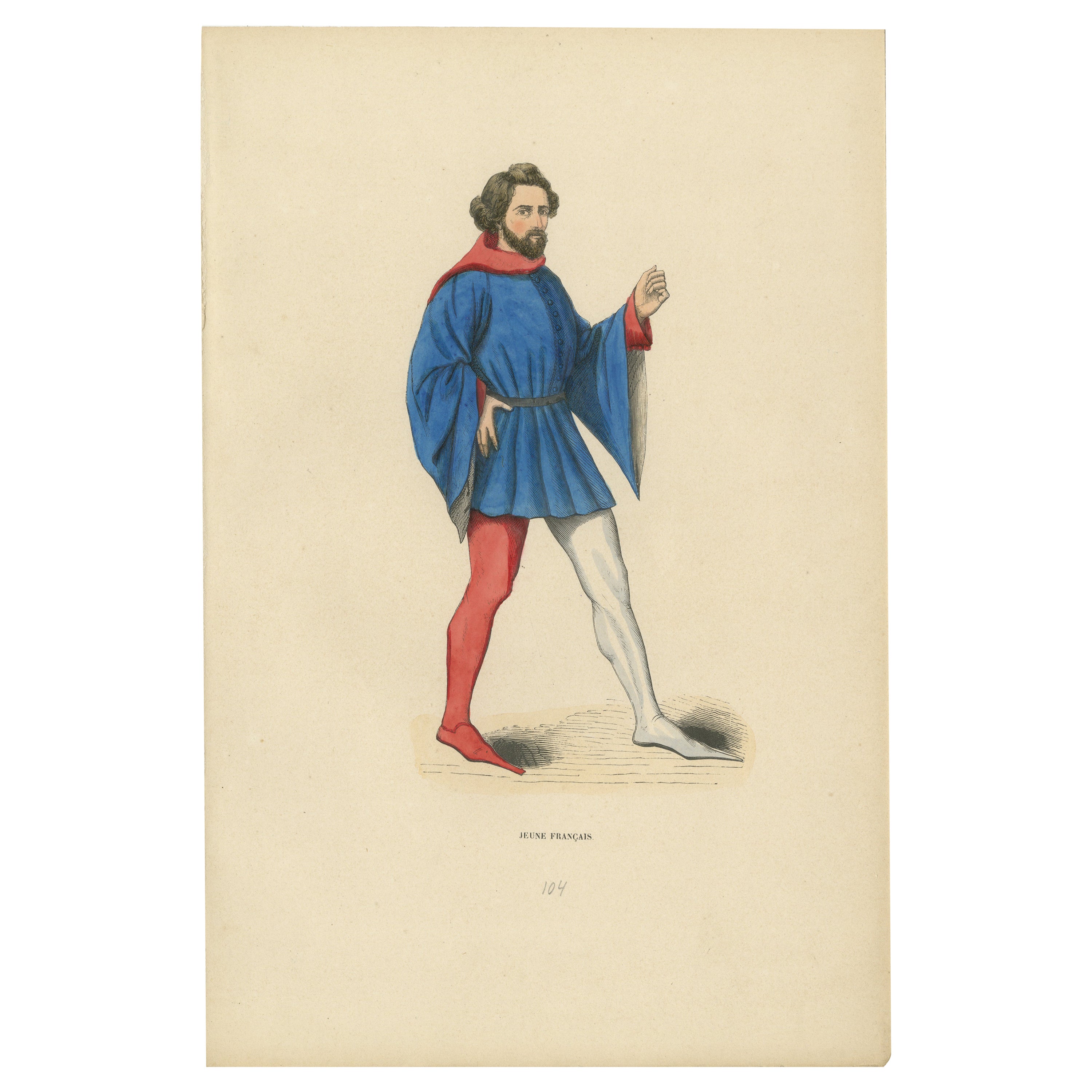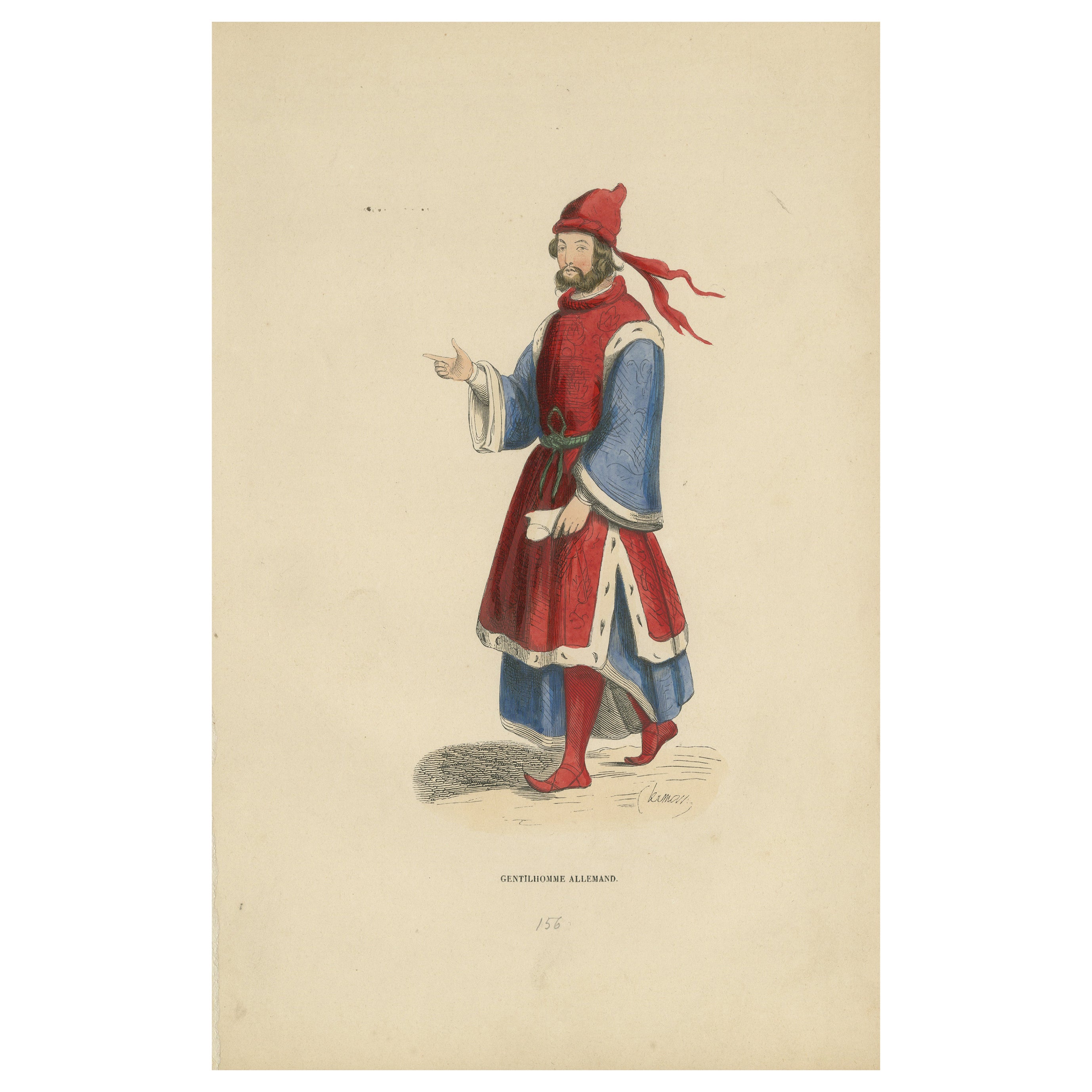Items Similar to Attire of a Medieval Scholar: The Learned Physician of the Middle Ages, 1847
Want more images or videos?
Request additional images or videos from the seller
1 of 6
Attire of a Medieval Scholar: The Learned Physician of the Middle Ages, 1847
About the Item
Title: "Attire of a Medieval Scholar: The Learned Physician of the Middle Ages"
This hand-colored lithograph, titled "Médecin" in the original French, is a detailed portrayal of a medieval physician's attire from the celebrated 1847 publication "Costume du moyen age d'après les manuscrits, les peintures et les monuments contemporains." The illustration captures the essence of a scholarly healer of the Middle Ages, emphasizing the significance of clothing as a marker of knowledge and status. Adorned in a vibrant red robe that reaches the ground, the physician's garment is both a sign of his professional role and a reflection of the period's fashion. The robe is complemented by a distinguished grey and black cloak, meticulously edged with a golden-yellow trim that signifies wealth and distinction. The cap he wears, red with a white band, suggests a customary headgear for men of medicine during the era.
The physician stands with a composed and thoughtful expression, holding what appears to be a small book or set of papers, perhaps indicative of his knowledge and readiness to offer counsel. The lithograph's hand coloring brings to life the textures and fabrics of the period, offering a window into the world of medieval customs and societal roles. This image is not only a visual record of historical attire but also a cultural symbol that conveys the reverence and gravitas attributed to medical professionals in a time when their expertise was both vital and revered.
The colors have a nice glow over them. Historically, egg whites, known as glair, and sometimes egg yolk were indeed used in illumination and painting, particularly in manuscripts, to give colors a brighter appearance and to add a sheen or gloss to the work. This technique was quite common during the Middle Ages and into the Renaissance.
Egg whites can be applied as a varnish over pigments to enhance their brightness and to protect the colors. This application could make the colors appear more vivid and also add a slight glossy sheen to the surface of the image.
Egg yolk, on the other hand, was commonly used as a binding agent in paint. It forms the basis of tempera paint, a medium that was widely used before the advent of oil painting. Egg yolk helps to create a durable and long-lasting color that adheres well to various surfaces.
In the context of the print from 1847, it's less likely that egg whites or yolks were used directly on the print, as by that time, commercial printing processes would have been more advanced and less reliant on such manual methods. However, if this print is a representation of an earlier style or is meant to mimic the appearance of hand-painted manuscripts, the original artists might have employed techniques or materials that gave a similar effect to those achieved with egg-based binders and varnishes.
- Dimensions:Height: 10.63 in (27 cm)Width: 7.09 in (18 cm)Depth: 0 in (0.02 mm)
- Materials and Techniques:
- Period:
- Date of Manufacture:1847
- Condition:Good. Overal light toning and light soiling but the image itself clean and hand-colored almost 200 years ago and still in expliciet colors. Aged paper with typically warm, yellowish-brown hue, mostly around the edges. Study the images carefully.
- Seller Location:Langweer, NL
- Reference Number:
About the Seller
5.0
Platinum Seller
These expertly vetted sellers are 1stDibs' most experienced sellers and are rated highest by our customers.
Established in 2009
1stDibs seller since 2017
1,922 sales on 1stDibs
Typical response time: <1 hour
- ShippingRetrieving quote...Ships From: Langweer, Netherlands
- Return PolicyA return for this item may be initiated within 14 days of delivery.
More From This SellerView All
- Scholar of the Arts: The Medieval Academic, 1847Located in Langweer, NLTitle: "Scholar of the Arts: The Medieval Academic" Description: This print illustrates a learned individual, likely a doctor of the arts or a scholar, from the medieval period. The...Category
Antique 1840s Prints
MaterialsPaper
- Jongleur of the Medieval Times: A Musician's Craft in the Middle Ages, 1847Located in Langweer, NLThis hand-colored engraving, titled "Jongleur," portrays a medieval entertainer, a precursor to modern-day musicians and performers. The term "jongleur" denotes a versatile artist commonly seen in medieval courts and public spaces, engaging audiences with music, poetry, and storytelling. In this print, the jongleur is shown playing a flute-like instrument, focused intently on his performance. His attire is strikingly colored, with a blue tunic that falls above the knee, allowing for ease of movement during his performance. The tunic is cinched at the waist by a darker belt, which helps to secure his garment during his active profession. Over his shoulders, he wears a red cape, which may symbolize his role as an entertainer, often brightly dressed to stand out in a crowd. He wears tight red hose, a common element of medieval clothing...Category
Antique 1840s Prints
MaterialsPaper
- Scholar of the Codex: A Medieval Jurist in Study, 1847Located in Langweer, NLThe image depicts a person labeled "Docteur des Lois," which translates to "Doctor of Laws." This term historically refers to an individual who has achieved advanced scholarly status in the field of law, equivalent to the modern term "Juris Doctor." The figure is seated at a lectern, deeply engrossed in a large book, which likely represents legal texts or scholarly works. The individual is attired in a robe with a fur-lined cape, suggesting a status of academic or professional distinction. The robe is red, a color often associated with higher education and learning. The headwear appears to be a type of turban, which was a common academic regalia in certain cultures and times. The setting and attire suggest that this person is a scholar or a high-ranking legal professional, possibly a university professor or a magistrate from the medieval or Renaissance period. Egg whites can be applied as a varnish over pigments to enhance their brightness and to protect the colors. This application could make the colors appear more vivid and also add a slight glossy sheen to the surface of the image. Egg yolk, on the other hand, was commonly used as a binding agent in paint. It forms the basis of tempera paint, a medium that was widely used before the advent of oil painting. Egg yolk helps to create a durable and long-lasting color that adheres well to various surfaces. In the context of the print from 1847, it's less likely that egg whites or yolks were used directly on the print, as by that time, commercial printing processes would have been more advanced and less reliant on such manual methods. However, if this print is a representation of an earlier style or is meant to mimic the appearance of hand-painted...Category
Antique 1840s Prints
MaterialsPaper
- Florentine Nobleman of the Middle Ages, 1847Located in Langweer, NLTitle: "Civilian Costume at the End of the 15th Century" Description: The image is a print from a series the "Costume du Moyen Age" dated 1847, and titled "Costume Civil de la Fin d...Category
Antique 1840s Prints
MaterialsPaper
- French Youth in Traditional Medieval Attire, 1847Located in Langweer, NLTitle: "French Youth in Traditional Medieval Attire" Description: This hand-colored engraving, titled "Jeune Français," which translates to "Young Frenchman," is part of the histori...Category
Antique 1840s Prints
MaterialsPaper
- Noble Bearing: A German Gentleman in Medieval Attire, 1847Located in Langweer, NLTitle: "Noble Bearing: A German Gentleman in Medieval Attire from 'Costume du Moyen Âge'" Description: This 1847 lithograph from the esteemed collection "Costume du Moyen Âge" showc...Category
Antique 1840s Prints
MaterialsPaper
You May Also Like
- Set of 9 Original Antique Prints of the Levant / Holy Land /Middle East. C 1850Located in St Annes, LancashireWonderful set of 9 prints of the Middle East Steel engravings after Thomas Allom Published by The London Printing And Publishing Co. Unframed. The measurement below is the paper ...Category
Antique 1850s English Islamic Prints
MaterialsPaper
- Original Antique Print of a Hoopoe, 1847, UnframedLocated in St Annes, LancashireGreat image of a hoopoe. Unframed. It gives you the option of perhaps making a set up using your own choice of frames. Lithograph after Cpt. Brown with original hand color. Publis...Category
Antique 1840s English Folk Art Prints
MaterialsPaper
- Original Antique Print of a Racehorse, 1847 'Unframed'Located in St Annes, LancashireGreat image of a racehorse. Unframed. It gives you the option of perhaps making a set up using your own choice of frames. Lithograph after George Stubbs with original hand color. ...Category
Antique 1840s English Folk Art Prints
MaterialsPaper
- Original Antique Print of Monkeys, 1847 'Unframed'Located in St Annes, LancashireGreat image of monkeys. Unframed. It gives you the option of perhaps making a set up using your own choice of frames. Lithograph after Cpt. Brown with original hand color. Publish...Category
Antique 1840s English Folk Art Prints
MaterialsPaper
- Original Antique Print of A Bat, 1847 'Unframed'Located in St Annes, LancashireGreat image of a bat. Unframed. It gives you the option of perhaps making a set up using your own choice of frames. Lithograph after Cpt. brown with original hand color. Published...Category
Antique 1840s English Folk Art Prints
MaterialsPaper
- Original Antique Print of Seals, 1847 'Unframed'Located in St Annes, LancashireGreat image of seals. Unframed. It gives you the option of perhaps making a set up using your own choice of frames. Lithograph after Cpt. brown with original hand color. Published...Category
Antique 1840s English Folk Art Prints
MaterialsPaper





